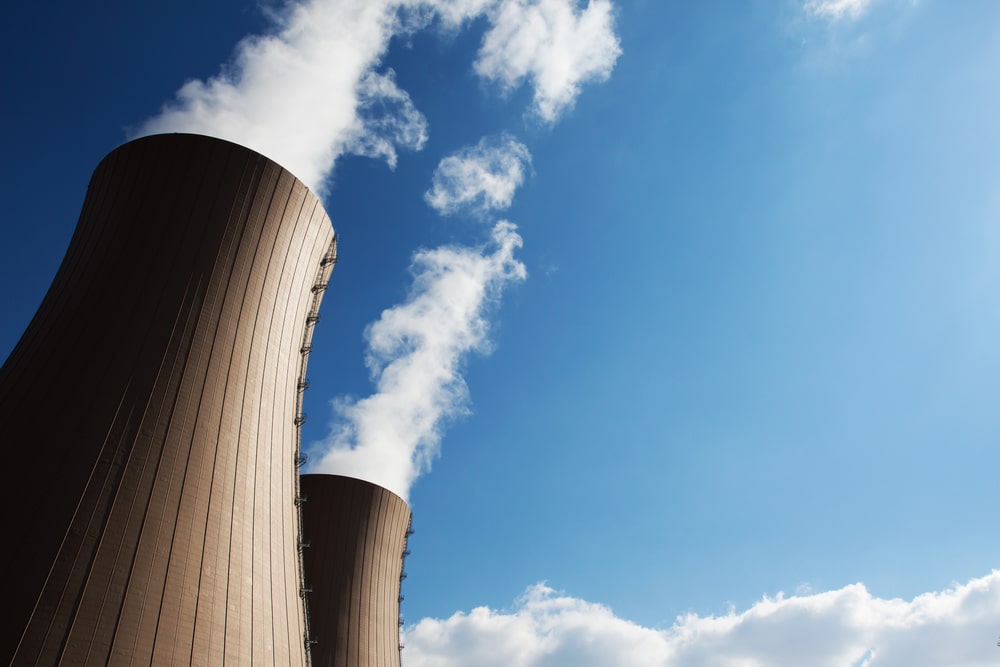As part of the world’s continued efforts to combat climate change and transition towards net zero, one important piece of the puzzle is new regulations and government policies.
Government regulation covers just about every sector, both public and private, and has been related to some of the most important shifts in industry.
The oldest of the U.S. government’s various consumer protection agencies, for instance, is the Food and Drug Administration, or FDA.
Its origins begin with the U.S. Department of Agriculture’s Division of Chemistry, a research wing with no regulatory powers that existed in the late 19th century.
After a number of food- and drug-related scandals such as Upton Sinclair’s The Jungle exposé on working conditions in animal feeding operations or the diphtheria antitoxin contamination incident in 1901 that resulted in the deaths of a dozen children, new laws were implemented that would lead to President Roosevelt signing the Food and Drug Act in 1906.
Since its inception, the FDA has given rise to countless regulations that benefit the general public. Some examples include:
- Banning radioactive drinks and harmful “drugs” like Elixir of Sulfanilamide
- Establishing canning and packaging standards
- Allowing for the prosecution of responsible officials of a corporation, as well as the corporation itself, for violations
- Authorizing the inspection of factories
- Regulating drugs before they hit the market

You can thank the FDA for the fact that this isn’t available for sale anymore.
The FDA has by no means exhausted the list of changes it has brought to an industry that state laws previously only protected in a patchwork manner.
Today, it’s very unlikely for someone to go out to a grocery store or restaurant and get sick from something relating to the ingredients. This wasn’t always the case a century ago. And we have the extensive protections put in place by the FDA to thank for that.
In the modern day, the fight against climate change is the next place where government intervention has to force compliance in a timely manner.
After all, oil and gas companies like Exxon already knew about climate change back in the ‘70s. They spent millions on research, hiring top scientists and building their own climate models. All to cover it all up when it turned out that the truth could hurt their bottom line.
(Exxon is famous for being one of the leaders behind the Global Climate Coalition. It was established in 1989 to question the science behind climate change and raise skepticism.)
Climate disclosure rules are merely one small piece required to put the world onto a net zero pathway. Climate disclosure will enable informed investor decisions and compel companies to reveal their true operations, similar to FDA-imposed nutrition labels.
What is Climate Disclosure?
Simply put, climate disclosure standards are legislation put in place to make it mandatory for companies to disclose how much their business operations impact climate change – and even how climate change impacts them.
Currently, corporations already adhere to a number of different reporting standards. Financial reporting is one of the most well-known, as quarterly earnings reports and such often impact share prices and market valuations.
Non-financial reporting metrics such as ESG (Environmental, Social and Governance)-related reporting have risen greatly in the past few years. Simply because investors have started viewing corporate responsibility as a key component of an attractive investment.
Climate disclosure certainly falls under the “E” in ESG. Many major companies are already voluntarily disclosing their emissions and other related information. But many use different metrics for reporting, while others may straight up leave out important details.
Proper climate disclosure regulation would require a standard framework that companies would be forced to follow when reporting their emissions and other climate-change-related details of their operations. It would work similarly to how the U.S. SEC mandates annual 10-K and quarterly 10-Q reports to be filed by listed companies according to U.S. GAAP accounting standards.
As an aside, something often used in emissions reporting are the terms “Scope 1”, “Scope 2”, and “Scope 3” emissions, also known as S1, S2, and S3.
These terms come from the Greenhouse Gas Protocol, a third-party emissions reporting standard that many companies use for calculating their emissions.
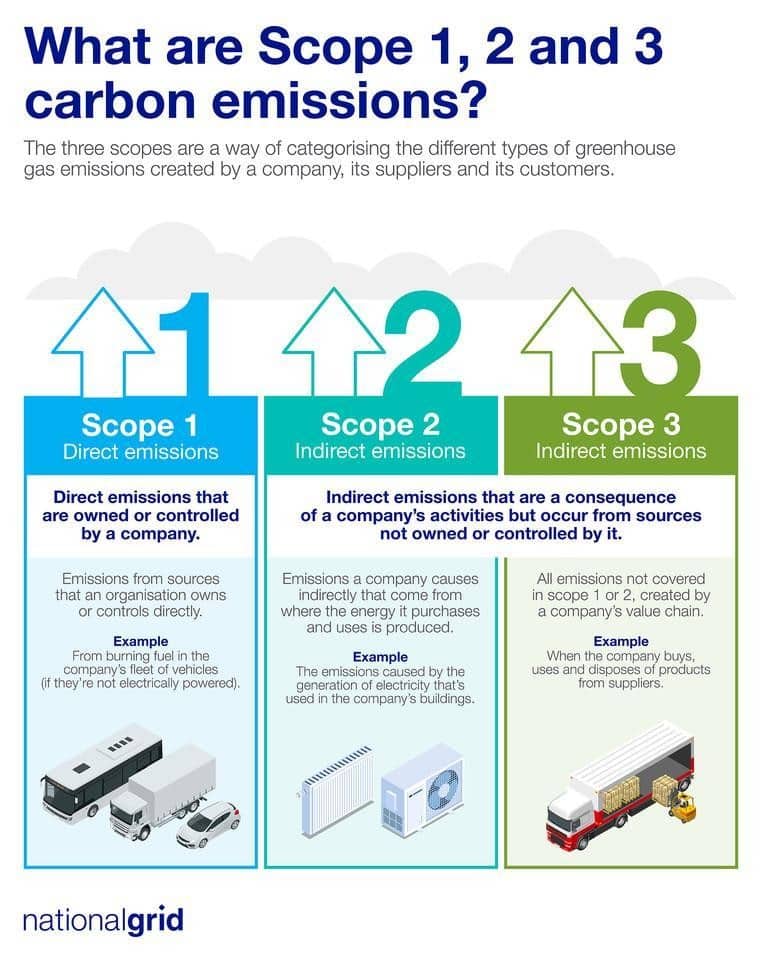 S1 emissions covers the emissions directly resulting from a company’s operations. It’s from sources they own and control, such as any buildings they occupy or vehicles they have.
S1 emissions covers the emissions directly resulting from a company’s operations. It’s from sources they own and control, such as any buildings they occupy or vehicles they have.
S2 emissions are indirect emissions that include the emissions produced from the energy the company uses. Examples of this would be the emissions generated by the electricity used to power the company’s offices. Or it can be the emissions produced when extracting the oil used by their employees to drive to said offices.
Lastly, S3 emissions are indirect emissions that cover the entire rest of a company’s value chain, both upwards and downwards. What this means is that all emissions from any products or services used or produced by the company would be covered.
This would include the emissions required to produce any parts or supplies the company uses in its business operations. The emissions the company’s products would produce down the line are also part of S3.
Let’s take an auto manufacturer as an example here. Their S1 emissions would include the emissions produced by the company’s offices, manufacturing plants, and fleet of delivery/service vehicles. Their S2 emissions would include the emissions generated by the electricity required to power said plants, and the oil to run their fleet of vehicles.
Finally, their S3 emissions would include the emissions involved in mining and producing all the materials and parts the company needs to actually make their cars, as well as all of the emissions produced by their cars in the future when their customers drive them.
As you can see, S3 emissions can be a big deal when compared to a company’s “operational” S1+S2 emissions! This is part of the reason why proper climate disclosure regulations are needed.
Why is Climate Disclosure Important?
Right now, in the U.S. and many other countries, there’s no single unifying standard for climate disclosure. Again, while many companies voluntarily do so, some may be trying to report their emissions in such a way as to make themselves look better.
One example of this comes from the oil and gas industry, where all of the biggest companies like Shell, Chevron, Exxon, and even Saudi Aramco only report S1+S2 emissions in their disclosures.
After all, it hardly matters how cleanly a company can extract oil and gas from the ground. What really matters is how all that oil and gas ends up getting burned as fuel, releasing significant carbon emissions that would fall under the company’s S3 emissions… which simply go unreported.
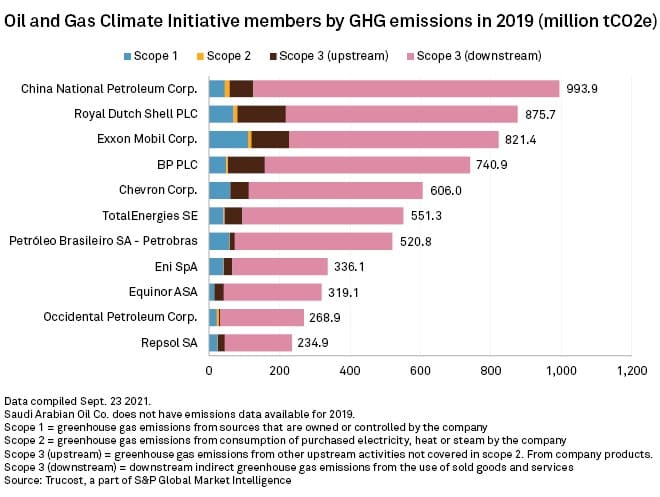 Currently, it’s estimated that S3 emissions account for 80-95% of the total carbon emissions from oil and gas companies, as shown above. So, by ignoring them, oil and gas companies can make themselves look better.
Currently, it’s estimated that S3 emissions account for 80-95% of the total carbon emissions from oil and gas companies, as shown above. So, by ignoring them, oil and gas companies can make themselves look better.
Another potentially surprising example comes in the form of Tesla, the electric vehicle (EV) company.
Prior to 2023, Tesla also refused to report its S3 emissions related to the various suppliers and vendors who produce parts for its cars.
In its most recent impact report, however, Tesla finally reported its S3 emissions alongside its operational S1+S2 emissions. To no surprise: its S3 emissions accounted for 98% of the company’s total emissions footprint.
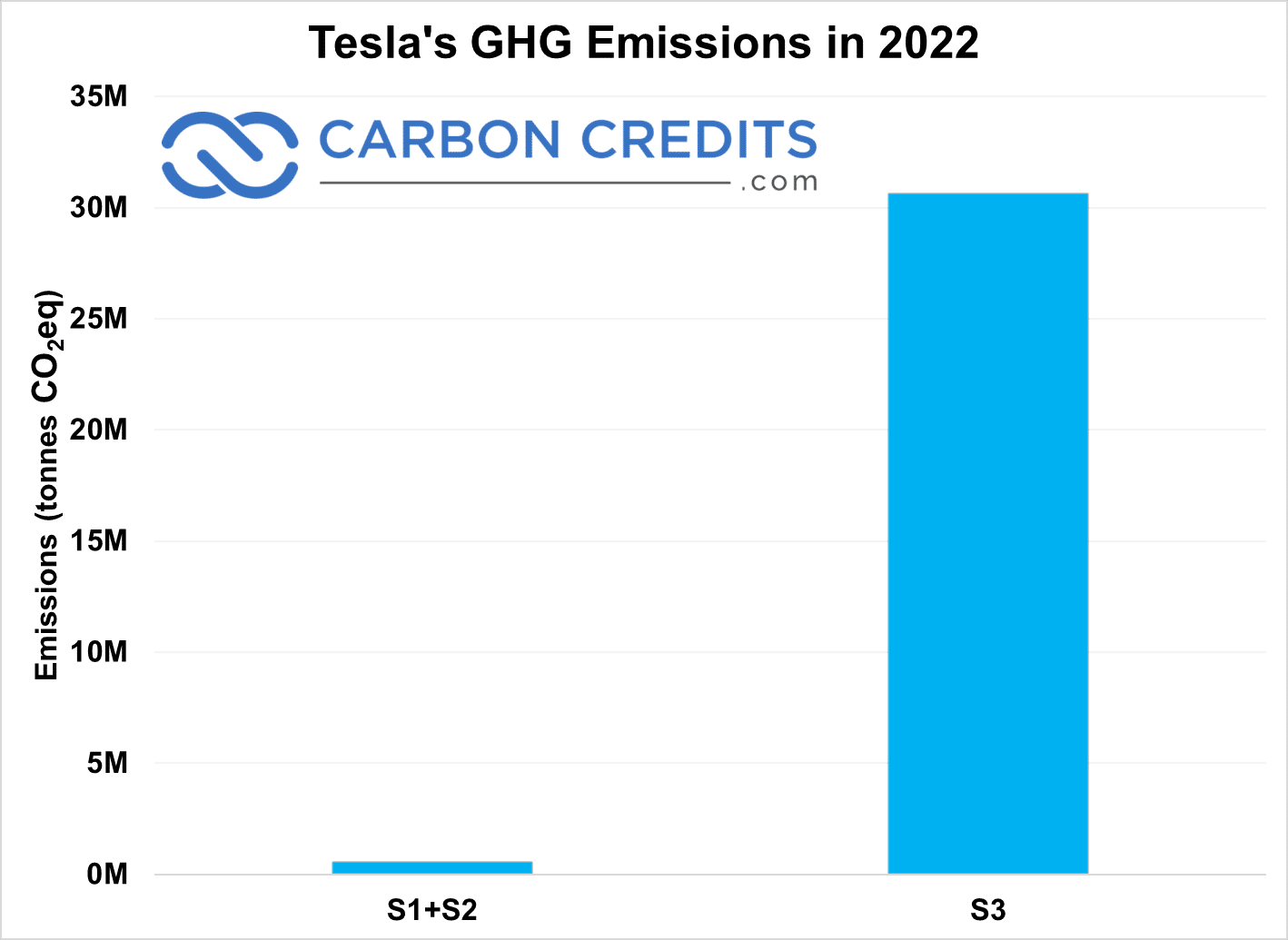 One thing you might not know is that currently, the process of making an EV is actually more carbon intensive than making a gas-powered vehicle. This is due to a number of factors, such as the complicated process of making an EV battery as well as the relative lack of economies of scale when comparing EV manufacturing with traditional car manufacturing.
One thing you might not know is that currently, the process of making an EV is actually more carbon intensive than making a gas-powered vehicle. This is due to a number of factors, such as the complicated process of making an EV battery as well as the relative lack of economies of scale when comparing EV manufacturing with traditional car manufacturing.
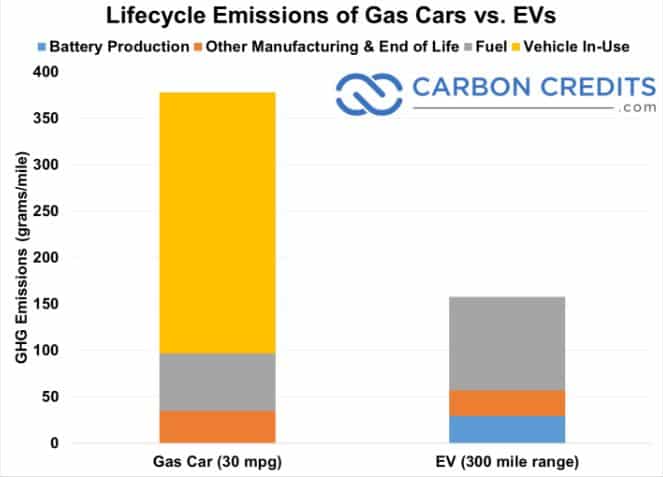 Of course, the lifetime emissions of an EV still wind up being significantly lower than that of a gas car. That’s because a gas car will continue to produce carbon while in use over its lifespan.
Of course, the lifetime emissions of an EV still wind up being significantly lower than that of a gas car. That’s because a gas car will continue to produce carbon while in use over its lifespan.
Still, Tesla may have wanted to hide the fact that right now, making an EV produces more emissions than making a regular car by hiding their S3 emissions.
You can think of proper climate disclosure like the nutrition labels on food packaging. It provides additional information regarding each product and allows extra transparency and metrics for the consumer to choose based on their preferences.
For instance, when grocery shopping, some people always choose the cheapest option, whereas others are happy to pay the premium for locally sourced organic produce. Some might prioritize fresher products, while others may have a preferred brand they go for.
Climate disclosure will allow for investors to do the same thing with companies they choose to invest their money in.
Let’s say you do your research on two different companies offering similar products or services. If the pros and cons of each respective company balance each other out, the fact that one company emits twice as much greenhouse gas (GHG) as the other might just be the factor that tips the scales in the other company’s favor.
This extra climate data transparency will also allow for governments to better meet their country-level climate change targets. Also known as their Nationally Determined Contributions (NDCs) as per the Paris Agreement.
And on the subject of GHG emissions, don’t forget – we’re already entering an era where climate disclosure may actually have significant material impact on a company’s operations.
In Europe, for example, the Emissions Trading System (ETS) covers roughly 40% of total GHG emissions in its member states. This includes a number of important sectors such as power generation, transportation, and the manufacturing industry.
Companies covered under the ETS have their emissions capped. Any excess emissions over a company’s annual limit must be offset through the purchase of allowances from other operators in the ETS who are under their own limits. If companies can’t come up with enough allowances to fully offset their own emissions, they face heavy fines.
-
Since the emissions of these companies can directly impact their financial results, emissions reporting is very important for companies that operate under the EU’s ETS framework.
While not every country and sector in the world has an emissions regulation framework like the ETS, it’s only a matter of time before governments serious about climate change adopt similar strategies.
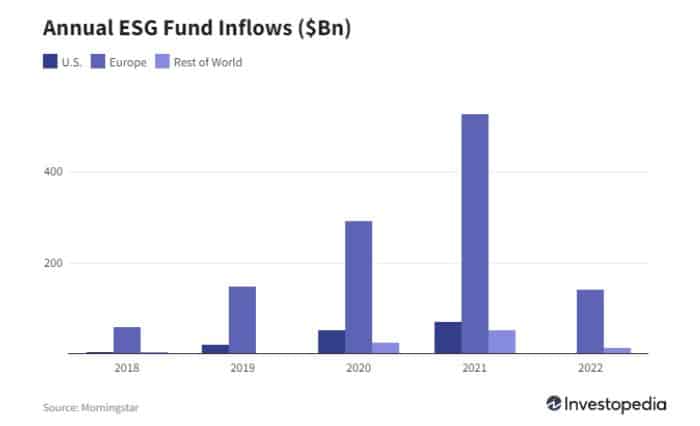
Even without taking such considerations into account, climate disclosure already has the potential to seriously impact corporate valuations. More and more investors decide they would rather put their money into climate-friendly businesses.
ESG funds have grown significantly over the past five years. Despite last year’s hit with global markets, ESG investing remains highly popular.
Many investors seek ESG-friendly deals; it’s time to implement climate disclosure rules.
Now, while we’ve mostly discussed the emissions reporting aspect of climate disclosure, there are other parts to it as well. In particular, how a business’s operations might be impacted by the effects of climate change.
In recent years, extreme weather events have become far more commonplace. And they can have significant adverse effects on both individuals and corporations alike.
Climate change can negatively impact agriculture and crop yield, for instance. Extreme weather events can also cause widespread damage from flooding, storms, and the like. Sustained periods of high temperatures can stress electrical grids and equipment, and even cause health issues and force business closures.
Some businesses are naturally more impacted by climate change than others. Whether it’s due to their physical location or the nature of their operations. Risks related to these factors would be very handy for investors to know as they do their due diligence.
Climate Disclosure Around the World
Right now, the EU and the UK are largely driving the push for more stringent climate regulation.
Every year, operators covered by the EU ETS must submit an emissions report that complies with the EU’s Monitoring and Reporting Regulation, subject for verification by a third-party verifier by March 31st of the following year.
The U.K. implemented their Climate-related Financial Disclosure Regulations in 2022. It became one of the first to make it mandatory for listed companies to report climate disclosures.
The EU and UK have definitely led the way in this area. Yet, many other countries have proposals in place to make climate disclosures mandatory for companies, including:
- Brazil,
- Canada,
- Hong Kong,
- New Zealand,
- Singapore,
- Switzerland, and
- The U.S.
The U.S. SEC, in particular, is currently in the process of finalizing their climate disclosure rules for public companies.
What Are the New SEC Climate Disclosure Requirements?
In March of 2022, the SEC proposed a set of climate disclosure requirements that would potentially apply to all SEC-registered domestic and foreign public companies.
The proposal would require companies to, in their registration statements and period reports (such as 10-K annual reports):
- Discuss the potential material impacts of climate-related risks on their business and how they’re being addressed. These include governance structure, strategy, risk management, metrics, and outlook.
- Disclose S1 and S2 emissions (for certain filers), eventually with “reasonable” independent third-party assurance same with financial statements. Certain companies, but not all, would also need to disclose their S3 emissions.
- Incorporate climate-related financial metrics and disclosures into their audited financial statements.
- Discuss any climate-change-related targets as well as transition plans, if applicable.
The authorities planned to finalize these proposed changes in April of 2023, but controversy surrounding the new rules delayed them to fall of the same year.
Many have pushed back against what they perceive as an overreach by the SEC with its new climate disclosure requirements.
Some question whether or not the SEC actually has the authority to force businesses to comply with this proposal that would significantly affect management processes for many businesses.
Predictably, many Republican lawmakers and business groups aren’t happy with these aggressive new rules. They believe it will add administrative burdens and costs to companies without providing comparable tangible benefits.
The U.S. Chamber of Commerce, for instance, has threatened to file a lawsuit if the rules are finalized. And Republican House Representatives like Ann Wagner of Missouri and Bill Huizenga of Michigan have expressed their concern about the legal authority of the SEC’s “radical regulatory agenda”.
Just recently, SEC Chair Gary Gensler highlighted the grave concern regarding Scope 3 emissions. He said that “Scope 3 disclosure is not as well developed, there’s not as many companies putting it out, and its frankly not yet as reliable“.
-
If the SEC enacts the proposed rules, they could require U.S. public companies to start reporting climate disclosures by 2025.
While no current guarantee exists that the SEC’s SEC’s proposal will pass in its current form – and it will almost certainly face legal challenges even if it does – other parts of the country have decided to act independently.
For instance, in California, Governor Newsom will soon sign Senate Bills 253 and 261 into law. Not only that, but these bills also have even more stringent requirements than what’s in the SEC’s proposal.
Combined, these rules – the first of their kind in the U.S. – would make climate disclosure mandatory for all businesses with over $1 billion in annual revenue operating in the state of California. Affecting both public and private corporations, these bills would apply to an estimated 5,344 companies. In addition, the bills would also require not only S1+S2 emissions reporting by 2026, but also S3 reporting by 2027.
Companies with an annual revenue over $500 million must start disclosing climate-related financial risks by the end of 2024.
Over in New York, Senate Bill 2023-S897A would roughly do the same thing as California’s SB253. It applies to U.S.-based companies doing business in New York with annual revenues exceeding $1 billion.
S897A is currently sitting with New York’s Senate Finance Committee. So it won’t come into effect until well after California’s SB253 does.
At the end of the day, other arms of the government will simply enact the same requirements. Companies operating in Europe already have to comply with climate disclosure regulations. And those who want to operate in California will soon have to follow suit.
New York and other blue states are likely to enforce climate disclosure reporting soon, forcing companies to either comply or risk losing access to large potential markets across the U.S. and the rest of the world.
As a partner at U.S. law firm Ropes & Gray LLP, one of the largest law firms in the world, put it:
- “The horse has already left the barn on climate risk disclosure.”
And despite the best efforts of business lobbyists and attorneys, there’ll be no getting the horse back in.

